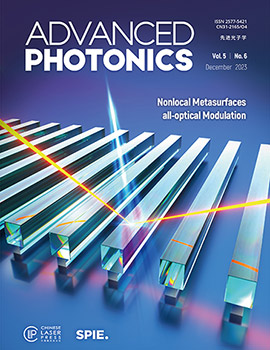拓扑朗道-齐纳纳米光子电路
IF 18.8
1区 物理与天体物理
Q1 OPTICS
引用次数: 1
摘要
摘要拓扑边缘态(TESs)产生于拓扑非平凡阶段,为光子集成电路的架构设计提供了一个强大的工具包,因为它们具有高度鲁棒性,并且强烈局限于拓扑绝缘体的边界。非常希望能够在光子实现中控制TES传输。增强有限尺寸光学晶格中TES之间的耦合能够在拓扑晶格的边界之间交换光能,从而促进TES传输的灵活控制。然而,现有的策略很少关注通过有限尺寸效应来增强TES之间的耦合效应。在这里,我们使用Landau–Zener模型建立了一个连接有限尺寸光学晶格中TES之间相互作用的桥梁,以便提供一种调制/控制拓扑模式传输的替代方法。我们通过实验证明了在硅波导晶格中,在电信波长下具有高效率的边到边拓扑传输。我们的研究结果可能为集成拓扑光子学的各种潜在应用提供动力。本文章由计算机程序翻译,如有差异,请以英文原文为准。
Topological Landau–Zener nanophotonic circuits
Abstract. Topological edge states (TESs), arising from topologically nontrivial phases, provide a powerful toolkit for the architecture design of photonic integrated circuits, since they are highly robust and strongly localized at the boundaries of topological insulators. It is highly desirable to be able to control TES transport in photonic implementations. Enhancing the coupling between the TESs in a finite-size optical lattice is capable of exchanging light energy between the boundaries of a topological lattice, hence facilitating the flexible control of TES transport. However, existing strategies have paid little attention to enhancing the coupling effects between the TESs through the finite-size effect. Here, we establish a bridge linking the interaction between the TESs in a finite-size optical lattice using the Landau–Zener model so as to provide an alternative way to modulate/control the transport of topological modes. We experimentally demonstrate an edge-to-edge topological transport with high efficiency at telecommunication wavelengths in silicon waveguide lattices. Our results may power up various potential applications for integrated topological photonics.
求助全文
通过发布文献求助,成功后即可免费获取论文全文。
去求助
来源期刊

Advanced Photonics
OPTICS-
CiteScore
22.70
自引率
1.20%
发文量
49
审稿时长
18 weeks
期刊介绍:
Advanced Photonics is a highly selective, open-access, international journal that publishes innovative research in all areas of optics and photonics, including fundamental and applied research. The journal publishes top-quality original papers, letters, and review articles, reflecting significant advances and breakthroughs in theoretical and experimental research and novel applications with considerable potential.
The journal seeks high-quality, high-impact articles across the entire spectrum of optics, photonics, and related fields with specific emphasis on the following acceptance criteria:
-New concepts in terms of fundamental research with great impact and significance
-State-of-the-art technologies in terms of novel methods for important applications
-Reviews of recent major advances and discoveries and state-of-the-art benchmarking.
The journal also publishes news and commentaries highlighting scientific and technological discoveries, breakthroughs, and achievements in optics, photonics, and related fields.
 求助内容:
求助内容: 应助结果提醒方式:
应助结果提醒方式:


